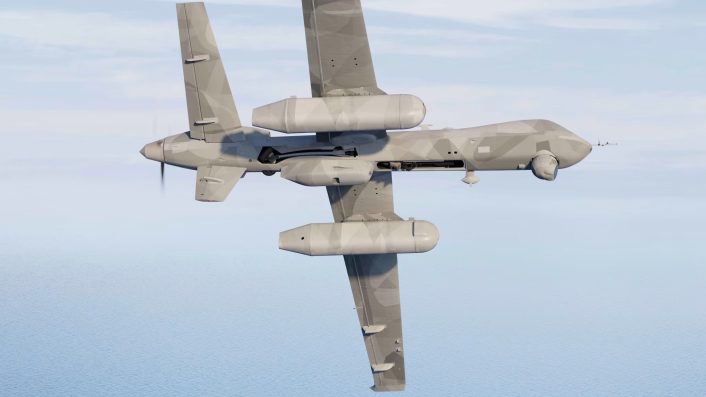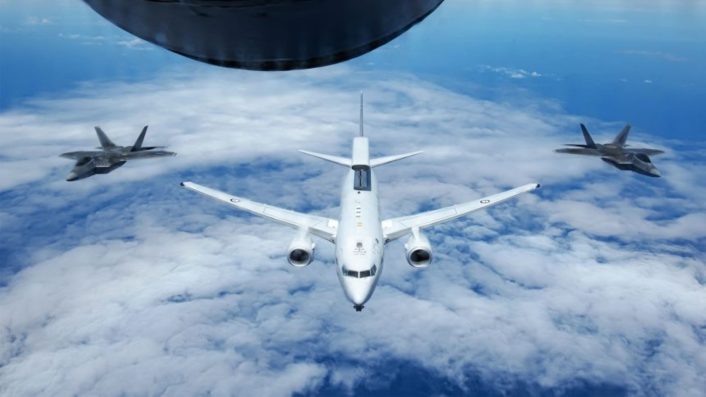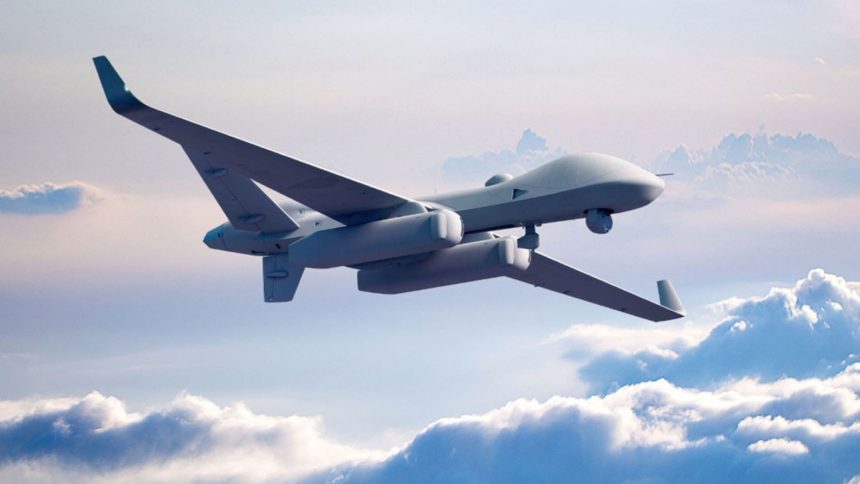Pairing Saab’s AEW sensors with the long-range, high-endurance MQ-9B allows persistent surveillance at low cost even from aircraft carriers.
General Atomics-Aeronautical Systems, Inc. (GA-ASI) and Sweden’s Saab have announced a collaboration for the development of a podded Airborne Early Warning and Control (AEW&C) capability for the MQ-9B Remotely Piloted Aircraft (RPA). The new capability, which will encompass the RPAs across the MQ-9 series, including the SkyGuardian, SeaGuardian, the United Kingdom’s Protector RG1, and the new MQ-9B STOL (Short Takeoff and Landing) model currently in development, is planned to be operational by 2026.
The AEW&C pod will be developed by Saab, with the unmanned platforms of the MQ-9 series to be offered by their developer GA-ASI, reflecting each company’s “core competency.” The development comes amid a diminishing manned airborne radar capability among Western air forces, including the retirement of the older E-3 Sentry AWACS (Airborne Early Warning and Control) and the bleak future of the E-7A Wedgetail.
Even more interestingly, this also comes after the UK’s Ministry of Defence said “the MQ-9 is being considered as a candidate for the Royal Navy’s requirement for Carrier Strike Airborne Early Warning.” In fact, the service is evaluating the feasibility of acquiring an unmanned system “capable of operating from the Queen Elizabeth Class Aircraft Carriers and providing persistent 24 hours surveillance.”
Company statements
“High and low-tech air threats both pose major challenges to global air forces,” said GA-ASI President David R. Alexander. “We’re developing an affordable AEW solution in cooperation with Saab, the leading provider of AEW&C systems, that will transform our customers’ operations against both sophisticated cruise missiles and simple but dangerous drone swarms.”
Notably, Alexander highlighted the will to develop a system which can be used where larger platforms are not feasible, and are sometimes replaced by less ideal helicopter-based solutions. “We’re also making AEW capability possible in areas it doesn’t exist today, such as from some navy warships at sea,” he said.
RELEASE: Saab and @GeneralAtomics develop unmanned airborne early warning solution. @GenAtomics_ASI will integrate Saab’s AEW sensors with their unmanned MQ-9B-platform. #defence #UAEW https://t.co/PryWrX0eQP
— Saab (@Saab) June 16, 2025
Pairing Saab’s AEW sensors with the world’s longest-range, highest-endurance UAS, the MQ-9B, “at sea or over land, the AEW mission package on MQ-9B will put air dominance within reach at a lower cost than legacy platforms,” the GA-ASI release added. The company further states the pods “will offer critical aloft sensing […] at a fraction of the cost of manned platforms,” beside higher operational availability than manned aircraft of the type.
Additionally, GA-ASI mentioned “AEW for MQ-9B will augment existing AEW fleets by extending their effective ranges,” suggesting the possibility of the unmanned AEW assets complementing the manned ones, possibly cooperating during the same mission.
Saab, in its own press release, said the “strategic cooperation […] will deliver persistent surveillance and situational awareness by providing continuous monitoring of designated areas.” Larger platforms not only have endurance limits because of the fuel, but also because of the crew; these limits are no longer a problem with drones, allowing surveillance to be continuous.
MQ-9のAEWの成否はこのポッド無くしては…という感じだけど見込み立ってるのか https://t.co/x9b1GGPWTi pic.twitter.com/dPzd4byGlh
— ふるーす (@kleinenf) September 22, 2024
“This unmanned medium-range AEW solution complements Saab’s existing portfolio of manned AEW&C systems including GlobalEye,” Saab’s statement added. “It will provide customers with a wider range of options, such as AEW capability from naval warships, to meet mission needs. The solution can be used stand-alone or in manned-unmanned teaming, leveraging the strengths of each capability.”
MQ-9 reinvented for maritime AEW in a peer conflict
The GA-ASI press release says the AEW&C kit for the MQ-9B is also meant for the drone’s British variant, designated the Protector RG1. As mentioned earlier, this also follows the drone being considered by the UK MoD for an AEW role embarked on Royal Navy carriers, replacing the Merlin HM2 Airborne Surveillance and Control aircraft.
クロウズネストAEW、中止になったって話ですが結局後任はどうするんですかねぇ。
MQ-9のAEW化モデルが一番やりやすいとはおもうものの、イギリスはUAV計画動かしてたからどうなるやら。 https://t.co/Kva3dLx0Fy pic.twitter.com/akT8MeDrtl
— imgurの人/とほほ電池@充電中 (@chageimgur) December 17, 2024
The Protector RG1 itself has progressed from flying around its designated and restricted airspace, around the home base of RAF Waddington in a series of tests in Feb. 2025, to an expanded distance envelope in regular airspace by receiving a Military Type Certificate from the UK Military Aviation Authority.
The role of the MQ-9B on an aircraft carrier would be “to provide a carrier strike group (CSG) with warning of air and surface threats, such as anti-ship guided weapons and strike aircraft, to allow for effective counter threat action.” Compared to the helicopter-based Crowsnest, the drone’s higher service ceilings would improve the overall radar coverage.
Obviously, the standard MQ-9B is not able to operate from an aircraft carrier as it is, so it will need modifications. These might largely be part of the publicized “STOL mission kit,” as well as some additional ones specific for that environment, which might make it even more useful in today’s scenarios.

A GA-ASI concept video of a “STOL mission kit” from Feb. 2023 already showed an MQ-9B SeaGuardian with the markings of U.S. Marine Corps’ VMU-1 (Marine Unmanned Aerial Vehicle Squadron-1). GA-ASI then recently tested the Gray Eagle STOL (Short Take-Off Landing) variant in a Counter-Unmanned Aerial Systems (C-UAS) trial firing Hellfire missiles and APKWS II rockets.
The company is also testing a STOL kit in a wind tunnel for the MQ-9B SeaGuardian and SkyGuardian drones. We analyzed that the STOL kit could be a rapidly strappable system for the existing MQ-9Bs, while the Gray Eagle’s C-UAS test might have served to quickly prove its STOL wing before its kitted form is tested on the MQ-9B for carrier operations.
Thus, the possibility that STOL-kitted MQ-9s flying with specialized systems, such as the STII and FINN pods or the new AEW kit, could quietly participate in ‘kill chain’ improvement in future cannot be excluded. Now, the mention of the “currently under development” MQ-9B STOL as being one of the variants envisioned to receive the new AEW&C capability marks a clear effort of how the STOL kit and its various podded capabilities are linked.
Beside the newly revealed AEW&C capability, counter-UAS and electromagnetic sensing/communications relay pods, another is one with a Sonobuoy Dispensing System (SDS) pods for the MQ-9B SeaGuardian in an Anti-Submarine Warfare (ASW) role. With even U.S. Air Force MQ-9A Reapers being prepared for a maritime warfare role, this bears how the drones are finding new importance in a high-end war.
General Atomics, alongside Hanwha Aerospace, made aviation history when #GrayEagleSTOL took off from a South Korean naval warship meant for helicopters and landed at a ground base.
The ability to operate from various warships unlocks new multi-domain operations for UAS. pic.twitter.com/OXVDLy1D7v
— General Atomics Aeronautical Systems, Inc (GA-ASI) (@GenAtomics_ASI) November 13, 2024
AEW MQ-9s amid a diminishing Western airborne radar fleet
The new AEW capability for the MQ-9 also seems to be spurred by a decision to make up for a diminishing fleet of manned airborne radar fleets in the U.S. and NATO’s European air forces. In fact, the U.S. Air Force is looking to replace its remaining 15 aging E-3 Sentry AWACS, after already having divested 16, as the aircraft based on the Boeing B707 is now a maintenance nightmare.
The AWACS is also used by Saudi Arabia, France, Japan (although based on the Boeing 767 platform) and NATO. France is also looking to replace its E-3s, possibly with Saab’s GlobalEye AEW&C platform. The United Kingdom is a former user of the AWACS, which the RAF (Royal Air Force) designated as the E-3D and retired in 2021. Three of the RAF aircraft were sold to Chile, with one of them used to harvest spare parts.
The Ministry of Defence has confirmed that the General Atomics MQ-9B is being evaluated as a potential carrier-based airborne early warning (AEW) platform for the Royal Navy.https://t.co/ijvelf1zsb
— UK Defence Journal (@UKDefJournal) May 19, 2025
E-7A Wedgetail’s future hits turbulence
The newer, more advanced E-7A Wedgetail now faces threat of cancellation as elements inside the DoD favor a cheaper alternative in the form of satellite-based surveillance, pushed by the U.S. Space Force, with Moving Target Indicator (MTI) sensors, notwithstanding its technical and tactical downsides. We also reported last week about comments made by Defense Secretary Pete Hegseth before the House and Senate Appropriations Committee casting further doubt on the future of the E-7A Wedgetail, stating that “President Trump has charged us with making the big, difficult decisions.”
The U.S. Air Force awarded Boeing a $1.2 billion contract in Feb. 2022 for the procurement of 26 E-7A Wedgetail to replace the aging E-3s, followed by an Aug. 9, 2024, $2.56 billion contract to rapidly prototype two aircraft. The prototypes are currently being built at Boeing’s facilities.

The aircraft is already operated by the Royal Australian Air Force, Republic of Korea Air Force and the Turkish Air Force, and will soon enter service with the Royal Air Force. In fact, on Sep. 20, 2024, the first of three Boeing E-7A Wedgetail AEW&C aircraft of the RAF completed its first test flight following conversion at Birmingham International Airport.
The cancellation of the USAF E-7 might also threaten the British and NATO’s acquisitions, and modifying the MQ-9 series of RPAs with AEW pods therefore seems to be another alternative or an interim solution until a space-based capability is available. Moreover, unmanned airborne radars are very much a viable option for first tier Western air forces, as displayed by China’s WZ-9 Divine Eagle unmanned AEW&C aircraft, which offers tremendous flexibility in airborne duration, persistent surveillance and redundancy.









